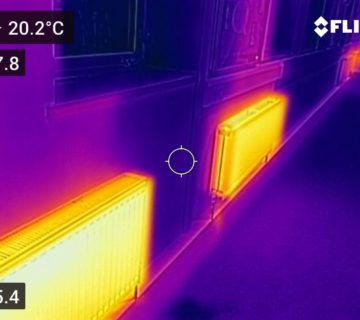Our director Alan Asbury was asked by the iCroner Journal to write an article on changes and updates to ESOS Phase 4 and the Energy Efficiency Directive (EED) across the EU for publication in May.
This to be specifically written for logistics and haulage.
Script below with link at the base of the article:
Energy Efficiency Directive changes
Following changes to ESOS Phase 3, the UK Government is improving its notification “MESOS” portal in readiness for ESOS Phase 4, for which data collection can commence as early as January 2026, advises Alan Asbury.
Background
The Energy Efficiency Directive (2012/27/EU) EED, was brought into being in the UK as the Energy Savings Opportunities Scheme (ESOS), commencing its rollout to large companies in 2014.
Requiring building, operational process, and transport fleet audits every four years, ESOS Phase 4 (2023-27) carries a qualification date of 31 December 2026. This means that the reference year to be used for calculations data, can be as early as 1 January to 31 December 2026.
The major changes so far agreed for ESOS Phase 4 are, subject to parliamentary scrutiny.
- Removal or the use of Display Energy Certificates (DECs) and Green Deal Assessments (GDAs) as acceptable routes to compliance.
- Progress against ESOS Phase 3 Action Plan commitments (made on MESOS portal on or after 5 March 2025) must be included in the ESOS Phase 4 assessment.
- Action Plans are to be reviewed annually, setting out the company’s plans to reduce energy and fuel use alongside targets and calculations demonstrating the energy benefits these measures will lead to.
- Explanation reporting where Action Plan commitments have not been met.
Changes to the MESOS IT portal for reporting ESOS notification of compliance and Action Plans are in beta testing with results well underway.
Voluntary reporting of net zero can be incorporated into Phase 4 and new PAS standards have been developed for this purpose.
ESOS Phase 5 (2027‒31) has also been confirmed. This will mandate net zero considerations within the ESOS audit. It is also likely that UK medium-sized companies (with thresholds linked to SECR parameters) will be captured in this round although details are awaited.
Transport
Transport has a major part to play in reducing fuel consumption and greenhouse gas (GHG/CO2e) emissions. As a UK sector, transport is responsible for the majority (29%) of all greenhouse gas emissions; followed by 20% building and product use, 14% from industry, 12% from agriculture, 11% from electricity supply, with the remainder from fuel supply, waste, land use and forestry.
Of that 29%, more than half (53%) of GHG emissions are from cars, with light goods vehicles (LCVs or vans) at 16%, HGVs account for 17%.
However, this is not the full story. UK roads facilitated 330.8 billion vehicle miles (bvm) of travel in 2023. Of this, 251.3bvm was from cars (a 3% increase on 2022 figures). Van figures were similar at 57.8bvm. There are 33.93 million cars on UK roads (81.3% of all vehicles) 4.8 million LCVs (11.5%), with 145,000 buses and coaches (0.3%).
Data to 2024, shows 542,000 HGVs on UK roads (1.3% of all vehicles). This sector reduced their driven miles by 2.5% to 16.9bvm. This despite continuing to trunk vast tonnages of cargo around the UK and keep the nation supplied.
Challenges
Despite their inevitably high fuel consumption and consequent GHG emissions, haulage companies have traditionally received limited Government support to address this. ESOS was perhaps the first opportunity for heavy fleet to independently baseline its energy and GHG data; enabling a better understanding and starting point. Where hauliers have been fortunate enough to have found transport qualified and specialist ESOS Lead Assessors, they have had 10 years to improve on their fleet operations.
The benefits for a haulier from a qualified fleet ESOS Lead Assessor include bringing an external “fresh pair of trained eyes” to a fleet that can:
- recommend, trial and prove/disprove, fleet measures, aerodynamics, and proposed technologies (using telematics and experience with other fleets)
- forensically and independently analyse data and telematics
- assess control and monitoring systems
- investigate poor driver performance
- advise on appropriate alternative fuels as well as proven measures and fuel savings solutions.
- assess capacity and options for site/fleet electrification, energy storage and resilience.
A good ESOS audit will provide the haulage company with a plethora of costed and cashable recommendations. It will also allow the company to safely consider, trial, or disregard alternative fuelling technologies, specific to their operations, or put these on the back burner until such time as they become commercially viable.
However, the vast majority of ESOS lead assessors are building energy managers only. As is stated in the Greenhouse Gas Protocol (2015; p72):
“It is important to recognise that the knowledge and qualifications of the individual(s) conducting the verification can be more important than those of the organization(s) they come from.
Companies should select organisations based on the knowledge and qualifications of their actual verifiers and ensure that the lead verifier assigned to them is appropriately experienced”.
Ensuring your Lead Assessor specialises in fleet and is qualified, chartered, experienced and registered with a credible registration body, are key to positive and beneficial outcomes and a compliant audit.
Europe
ESOS or the EU EED applies across the 27 EU Member States, Phase 4 has evolved to ensure that the EU target of 55% GHG reductions by 2030 (against 1990 baseline) are met.
Legislative changes include thresholds no longer being employee numbers and financial figures as in the UK. Instead, any company that meets or exceeds 10 Tera-Joules (TJ) of energy becomes mandated to act on the legislation. 10TJ is around 2.8 million kWh: Importantly for hauliers, that is around 263,000 litres of diesel. This will bring huge numbers of medium-sized companies into the legislation, disproportionately affecting larger numbers of small hauliers.
The EU EED Phase 4 will apply to UK companies with operations that meet this new threshold in any of the 27 EU member states.
As the UK EED (ESOS) moves towards carbon reduction, the 27 EU Member States remain focused on energy and fuel efficiency. In both scenarios, it is critical that raw (litre and kWh) data is captured to provide customers and suppliers with accurate Scope 3 carbon data.
By implementing recommendations for energy and fuel efficiency measures, technologies, controls, and behaviours set out in their specialist fleet ESOS reports, absolute (total) emissions and appropriate intensity metrics (eg kWh per tonne.mile driven, or packages/pallets/cages delivered) should begin to reduce.
Expectations and Opportunities
Hauliers now regularly schedule their “last mile” deliveries via smaller, often BEVs from hubs to final destinations in the retail environment. This improves air quality and reduces the difficulties encountered by HGVs navigating busy town centres. As more low emission zones are instigated in UK cities, and the role of the HGV increasingly becomes the workhorse of highways and motorways, there is potential to free up capacity by moving some heavy freight to rail. Certainly, rail-freight companies are alive to the challenges and the need for UK investment in deeper rail electrification.
The UK rail network remains only 37.7% electrified, with 6049km of electrified track (47% Global average). For the rail network to achieve net zero by 2050, requires another 28% of lines to be electrified. In rail-freight terms, an additional 800 miles of electrification could enable 95% of freight to be electrically hauled.
Moreover, just 60 miles of infill electrification around Liverpool, Leeds, Birmingham, Willesden, London Gateway, and Felixstowe, at an estimated cost of around £100 million; allows decarbonisation of 2 million train miles, annually. This equates to annually removing 80 million diesel HGV miles from Britain’s roads. Thereby allowing HGV drivers more efficient utilisation, fewer road repairs, improved air quality, and reduced emissions.
Practicalities
Euro VII comes into effect from 2026. This applies to new petrol, diesel, hybrid, and BEV cars, plus vans, lorries and buses. It will factor tyre and brake particulate matter. Emissions levels must be maintained beyond the current 10-year period and BEV/PHEV battery degradation will be subject to testing.
Heavy haulage is in a state of transition with enhanced aerodynamics, reducing drag and improving fuel efficiency. Artificial intelligence provides savings and opportunities for visibility. Monitored, and actioned telematics, can make a huge reduction in emissions as can good routing technology, training, and driver behaviour.
Several large UK hauliers are trialling various alternative fuels (each with its own challenges) and procuring Electric “e” HGVs. Access to appropriate rapid charging infrastructure is improving slowly with high-capacity transformers to charge large vehicle batteries at speed, to assist this to become mainstream. This relies on available and low carbon grid capacity alongside considered interlinks between energy infrastructure, transport, and energy storage.
Much of the above can be advanced significantly from a well-considered ESOS report.
An electrified rail system with appropriately sited, integrated, and interconnected distribution railheads and hubs would allow less long-distance road trunking and more connected short distance road deliveries in increasingly electrified vehicles.
All of this demands a joined-up approach to national grid infrastructure, installation of wind, wave, tidal, and solar technologies with varied energy storage, rail networks, and interconnecting road systems. It will require a government that recognises the magnitude of the chasm ahead, taking a leap for the good of the country. This will also allow follow through on its legal requirements under the Climate Change Act (2008) and its ambitions to be net zero carbon by 2050; Ambitions that are already demonstrating a growth rate of the green sector at triple that of the UK as a whole, and according to the CBI, pumping £28.8 billion into the economy.
Copyright © 2025 Croner-i Ltd and/or its affiliates. All rights reserved.
https://app.croneri.co.uk/feature-articles/energy-efficiency-directive-changes?product=143&q_token=be55a1399a14b8b523047d2512b1e637#WKID-202505081355450888-08792548



